Microalgae Oil Production Using Wastewater in Japan—Introducing Operational Cost Function for Sustainable Management of WWTP
Abstract
:1. Introduction
1.1. Microalgae Oil Production and Wastewater Treatment
1.2. Microalgae Oil Production and Oxidation Ditch (OD) Process
1.3. Purpose of This Study
2. Methodology
2.1. Suitability Detection of OD Process WWTP for Microalgal Oil Production (Suitability)
2.1.1. Suitability of Environmental Conditions for Microalgae Oil Production Based on the Lid and Location (Suitability)
2.1.2. Suitability of Facility Utilization Rates Based on Current Capacity and Average Daily Throughput (Suitability)
2.1.3. Availability of Exhaust Heat and Discharged CO2 Associated with the Geography of the WWTP (Suitability)
2.2. Scenarios for the Introduction of Microalgal Oil Production (Existing and Algal Scenario)
2.2.1. Existing Scenario of Awano WWTP (Existing Scenario)
2.2.2. Introduction of Microalgae Oil Production Process at Awano WWTP (Algal Scenario)
2.2.3. Treatment Volume of the Algal Scenario Introduced in Awano WWTP (Algal Scenario)
2.2.4. Algal Scenarios A and B (Algal Scenario)
2.3. Cost Function in Microalgal Oil Production Scenario (Cost Function)
2.3.1. Categorize the Algal Scenario to Five Process (Cost Function)
2.3.2. The Functions and Variables for Calculating Each Process (Cost Function)
2.3.3. Cultivation and Harvesting Process (Cost Function)
2.3.4. Primary Enrichment by Sedimentation Process (Cost Function)
2.3.5. Secondary Enrichment by Dehydration Process (Cost Function)
2.3.6. Hydrothermal Liquefaction Process (Cost Function)
2.3.7. Biocrude Selling Prices and Dehydrated Sludge Disposal Cost (Cost Function)
2.4. Environmental Burden in Microalgal Oil Production Scenario
3. Results and Discussion
3.1. Results of the Operation Cost for the Three Scenarios
3.2. Changes in the Cost with the Scale of the Daily Water Treatment Volume (1000 m3)
3.3. Effect of Changing Key Assumptions in the Algal Scenario
4. Conclusions
Author Contributions
Funding
Conflicts of Interest
Appendix A

| Operating Cost ($/m3-w.w.) | ||||
|---|---|---|---|---|
| Existing | Algal A | Algal B | Remarks | |
| Use of exhaust CO2 gas as free | - | ✓ | ✓ | |
| Use of discharged heat | - | ✓ | - | |
| Water-treat / Cultivation | ||||
| Electricity costs | 0.26 | 0.16 | 0.16 | [18], CHA |
| Maintenance inspection cost | 0.05 | 0.05 | 0.05 | Same, [18] |
| labor cost | 0.22 | 0.22 | 0.22 | Same, [18] |
| Primary Concentration (Gravity Concentration) | ||||
| Electricity & chemical costs | - | 0.25 | 0.25 | CSE |
| Maintenance inspection cost | 0.02 | 0.02 | 0.02 | Same, [18] |
| Secondary Concentration (Centrifugal Dehydration) | ||||
| Electricity costs | 0.004 | 0.03 | 0.03 | [18], CDR |
| Maintenance inspection cost | 0.06 | 0.06 | 0.06 | Same, [18] |
| Chemical cost (polymer flocculant*) | 0.02 | - | - | [18], Algal included in CSE |
| labor cost | 0.12 | 0.12 | 0.12 | Same, [18] |
| Deodorizing Equipment | ||||
| Electricity costs | 0.01 | 0.01 | 0.01 | Same, [18] |
| Maintenance inspection cost | 0.03 | 0.03 | 0.03 | Same, [18] |
| Activated carbon cost | 0.37 | 0.37 | 0.37 | Same, [18] |
| Dehydrated sludge disposal cost | 0.18 | - | - | PDS × DS |
| Sales income of biocrude | - | −0.04 | −0.04 | −PBC × BC |
| HTL cost (heat recovery 86%) | - | - | 0.07 | CHTL × 14% |
| Total | 1.34 | 1.29 | 1.36 | |
References
- Shahid, A.; Malik, S.; Zhu, H.; Xu, J.; Nawaz, M.Z.; Nawaz, S.; Alam, M.A.; Mehmood, M.A. Cultivating microalgae in wastewater for biomass production, pollutant removal, and atmospheric carbon mitigation; a review. Sci. Total Environ. 2020, 704, 135303. [Google Scholar] [CrossRef] [PubMed]
- Ishizaki, R.; Noguchi, R.; Putra, A.S.; Ichikawa, S.; Ahamed, T.; Watanabe, M.M. Reduction in Energy Requirement and CO2 Emission for Microalgae Oil Production Using Wastewater. Energies 2020, 13, 1641. [Google Scholar] [CrossRef] [Green Version]
- Algae Industry Incubation Consortium. Japan Annual Report of the Microalgae Pilot Project for Biofuel Production 2019; Algae Biomass and Energy System R&D Center, University of Tsukuba: Tsukuba, Japan, 2019; pp. 28, 29, 35, 107. [Google Scholar]
- Choi, H.I.; Hwang, S.-W.; Sim, S.J. Comprehensive approach to improving life-cycle CO2 reduction efficiency of microalgal biorefineries: A review. Bioresour. Technol. 2019, 291, 121879. [Google Scholar] [CrossRef] [PubMed]
- Oshita, K.; Furubayashi, T.; Nakata, T. The Analysis on Performance of Microalgae-based Biofuel Production System Considering Regional Climate Condition and Transportation. J. Jpn. Inst. Energy 2011, 90, 1047–1056. [Google Scholar] [CrossRef]
- Doshi, A.; Pascoe, S.; Coglan, L.; Rainey, T. The financial feasibility of microalgae biodiesel in an integrated, multi-output production system. Biofuels Bioprod. Biorefining 2017, 11, 991–1006. [Google Scholar] [CrossRef]
- Narita, Y. Annual Report of Sewer Statistics 2017; Japan Sewage Works Association: Tokyo, Japan, 2019; Volume 74, p. 90. [Google Scholar]
- Australian Science and Technology Heritage Centre Technology in Australia 1788–1988. Available online: https://www.austehc.unimelb.edu.au/tia/184.html (accessed on 16 August 2020).
- Akiyama, C.M. Sustainability Study of Sewerage Project Based on Future Estimated Population. Soc. Environ. Sci. Jpn. 2019, 32, 46–52. [Google Scholar] [CrossRef]
- Okaniwa, Y.; Mihara, Y.; Okajima, K.; Tanaka, T. Economical Evaluation of Small Scale Biogas Systems Based on Data of Biogas Plants in Operation. Water Land Environ. Eng. 2019, 77, 635–638. [Google Scholar] [CrossRef]
- Matsuda, K.; Iwahori, K. Policy Evaluation of Night Soil and Sludge Intensive Treatment Systems for Regional Resources Recycling. Jpn. J. Water Treat. Biol. 2018, 54, 29–38. [Google Scholar] [CrossRef] [Green Version]
- Wang, T.; Yabar, H.; Higano, Y. Feasibility of Combining an Algae-to-Oil System with Advanced Sewage Treatment in Japan. Stud. Reg. Sci. 2012, 42, 527–544. [Google Scholar] [CrossRef]
- Jimenez, C. Relationship between physicochemical variables and productivity in open ponds for the production of Spirulina: A predictive model of algal yield. Aquaculture 2003, 221, 331–345. [Google Scholar] [CrossRef]
- Tochigi Prefecture Prefectural Land Maintenance Business Meeting. Public Sewage of Tochigi; Tochigi Prefecture Prefectural Land Maintenance Business Meeting, Ed.; Tochigi Prefecture: Utsunomiya, Japan, 2013; pp. 3, 4, 19, 20. [Google Scholar]
- Demura, M.; Yoshida, M.; Yokoyama, A.; Ito, J.; Kobayashi, H.; Kayano, S.; Tamagawa, Y.; Watanobe, M.; Date, N.; Osaka, M.; et al. Biomass productivity of native algal communities in Minamisoma city, Fukushima Prefecture, Japan. Algal Res. 2018, 29, 22–35. [Google Scholar] [CrossRef]
- Yamazaki, K.; Saito, M.; Shukuya, M. Exergy Analysis on a Community Heating System Using Biomass Generated by Local Forest: A case study on Shimokawa town, Hokkaido. J. Environ. Eng. Trans. AIJ 2016, 81, 295–305. [Google Scholar] [CrossRef]
- Wibawa, D.; Nasution, M.; Noguchi, R.; Ahamed, T.; Demura, M.; Watanabe, M. Microalgae Oil Production: A Downstream Approach to Energy Requirements for the Minamisoma Pilot Plant. Energies 2018, 11, 521. [Google Scholar] [CrossRef] [Green Version]
- Nakajima, E.; Kotsuka, T.; Nakano, Y.; Nakazono, S. Study of Construction in Cost and Energy Consumption Calculation Method for Sewage Treatment System; Japan Institute of Wastewater Engineering and Technology: Tokyo, Japan, 2016; pp. 175–180. [Google Scholar]
- Gohda, S. Recent Technologies of Thickening and Dehydration in Sludge Treatment.pdf. J. Soc. Powder Technol. Jpn. 2010, 38, 177–183. [Google Scholar] [CrossRef]
- Torii, S.; Okajima, I.; Sako, T. Treatment and Energy Recovery of Sewage Sludge by High-pressure Superheated Steam Oxidation. J. Jpn. Inst. Energy 2013, 92, 945–956. [Google Scholar] [CrossRef] [Green Version]
- Anastasakis, K.; Biller, P.; Madsen, R.; Glasius, M.; Johannsen, I. Continuous Hydrothermal Liquefaction of Biomass in a Novel Pilot Plant with Heat Recovery and Hydraulic Oscillation. Energies 2018, 11, 2695. [Google Scholar] [CrossRef] [Green Version]
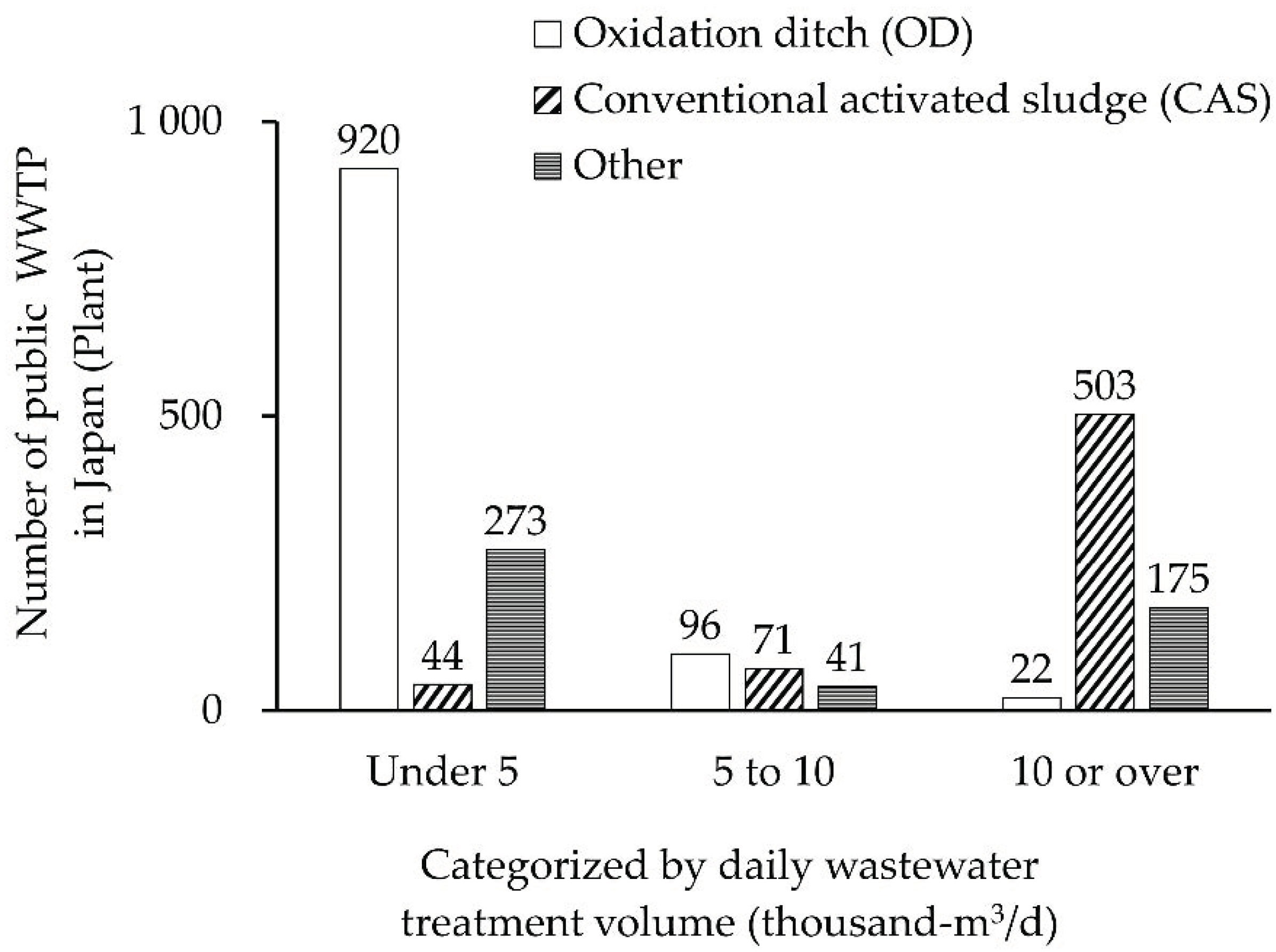
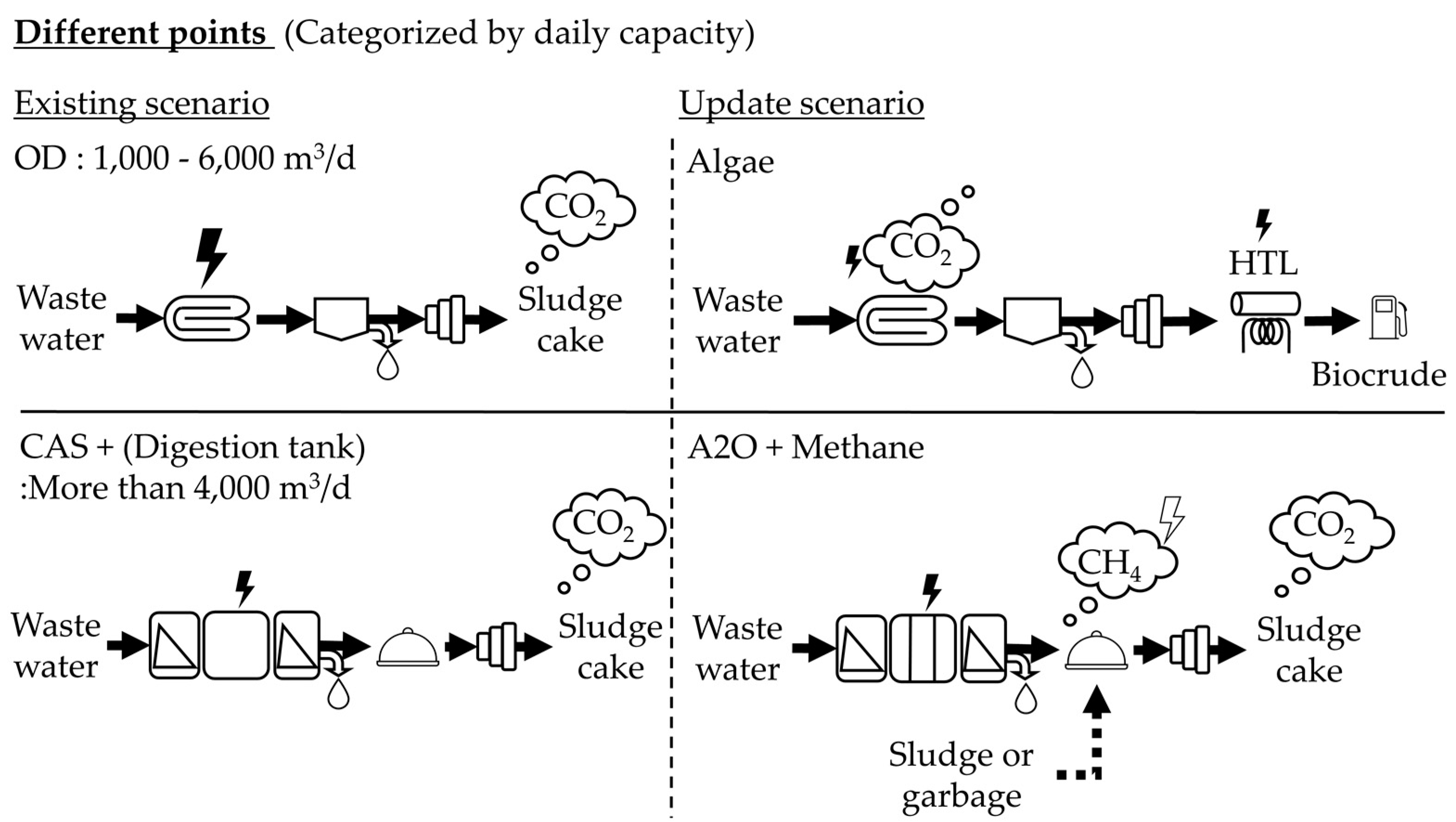


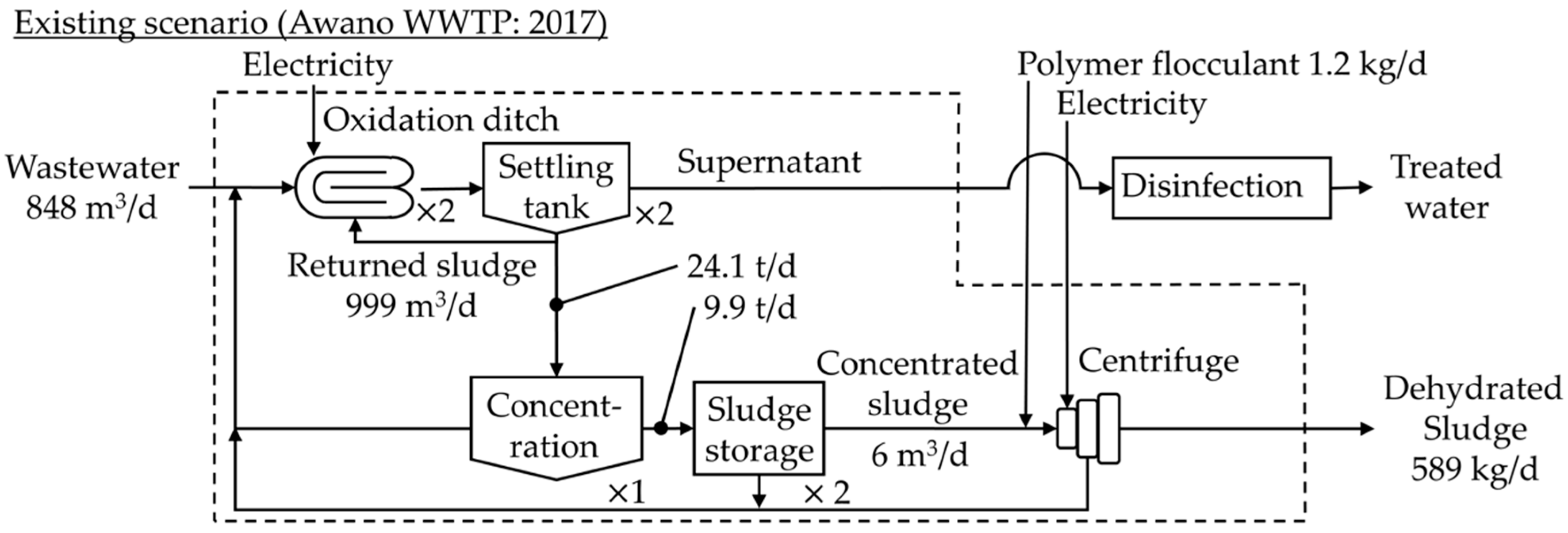
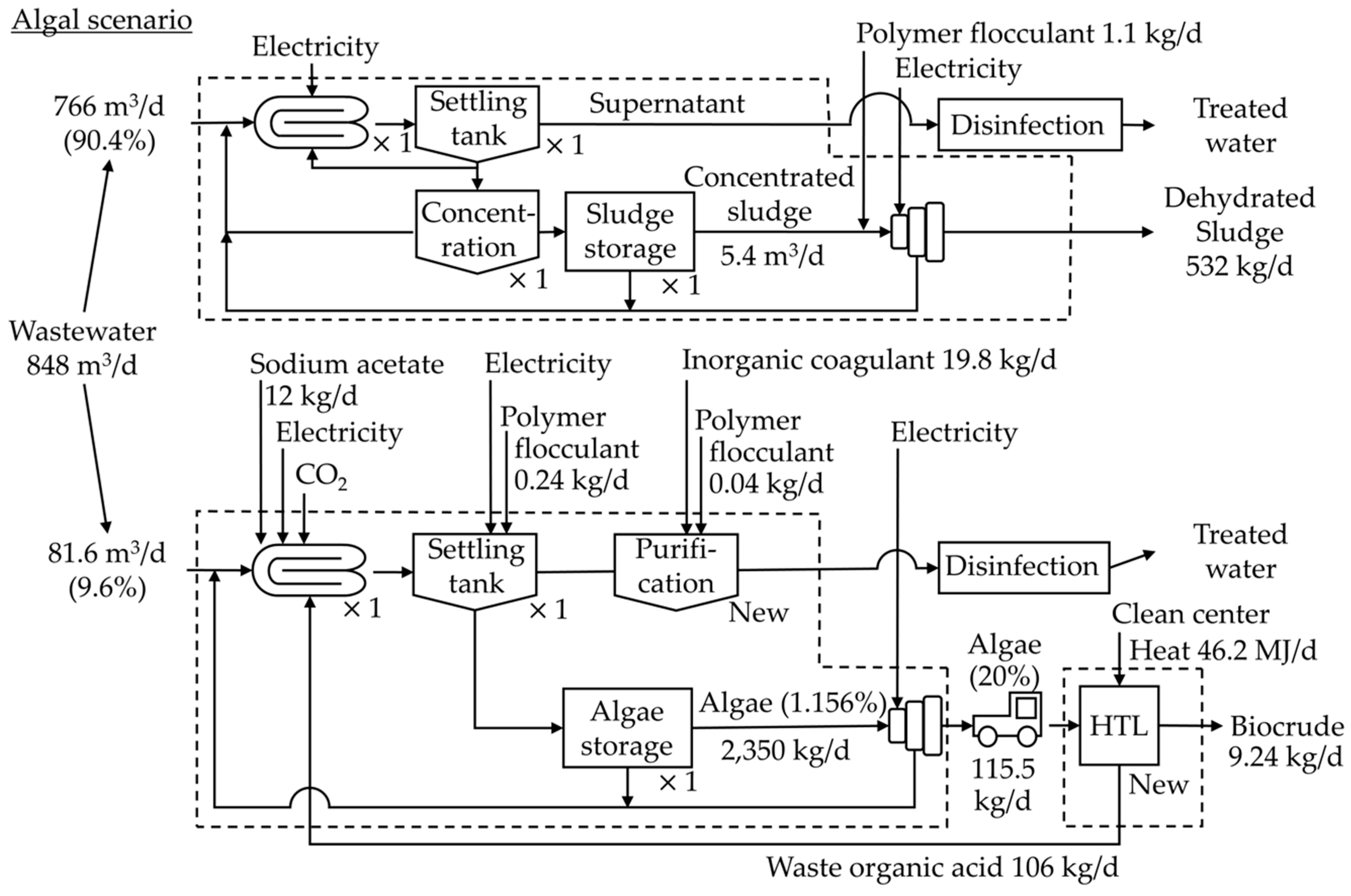
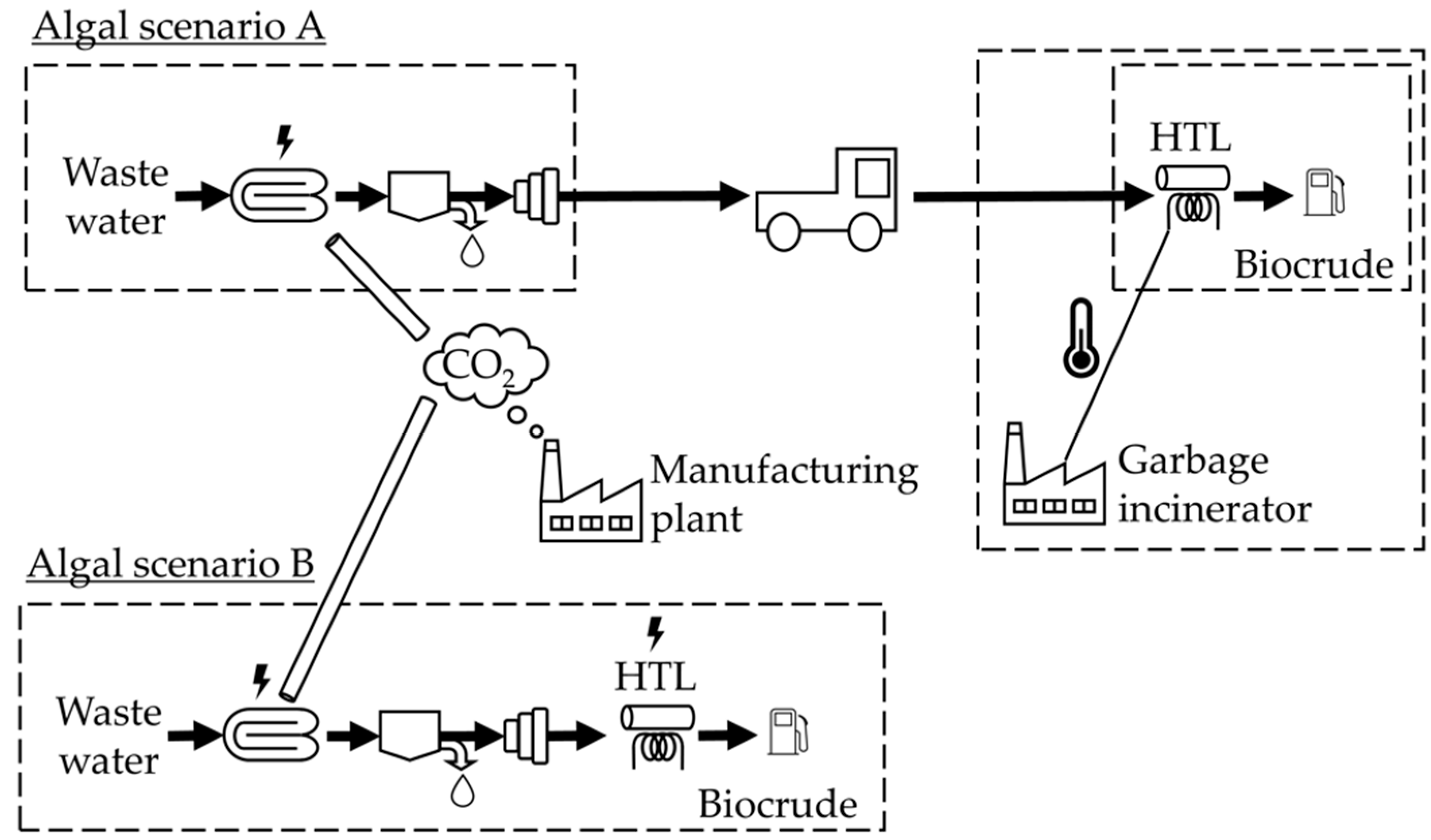
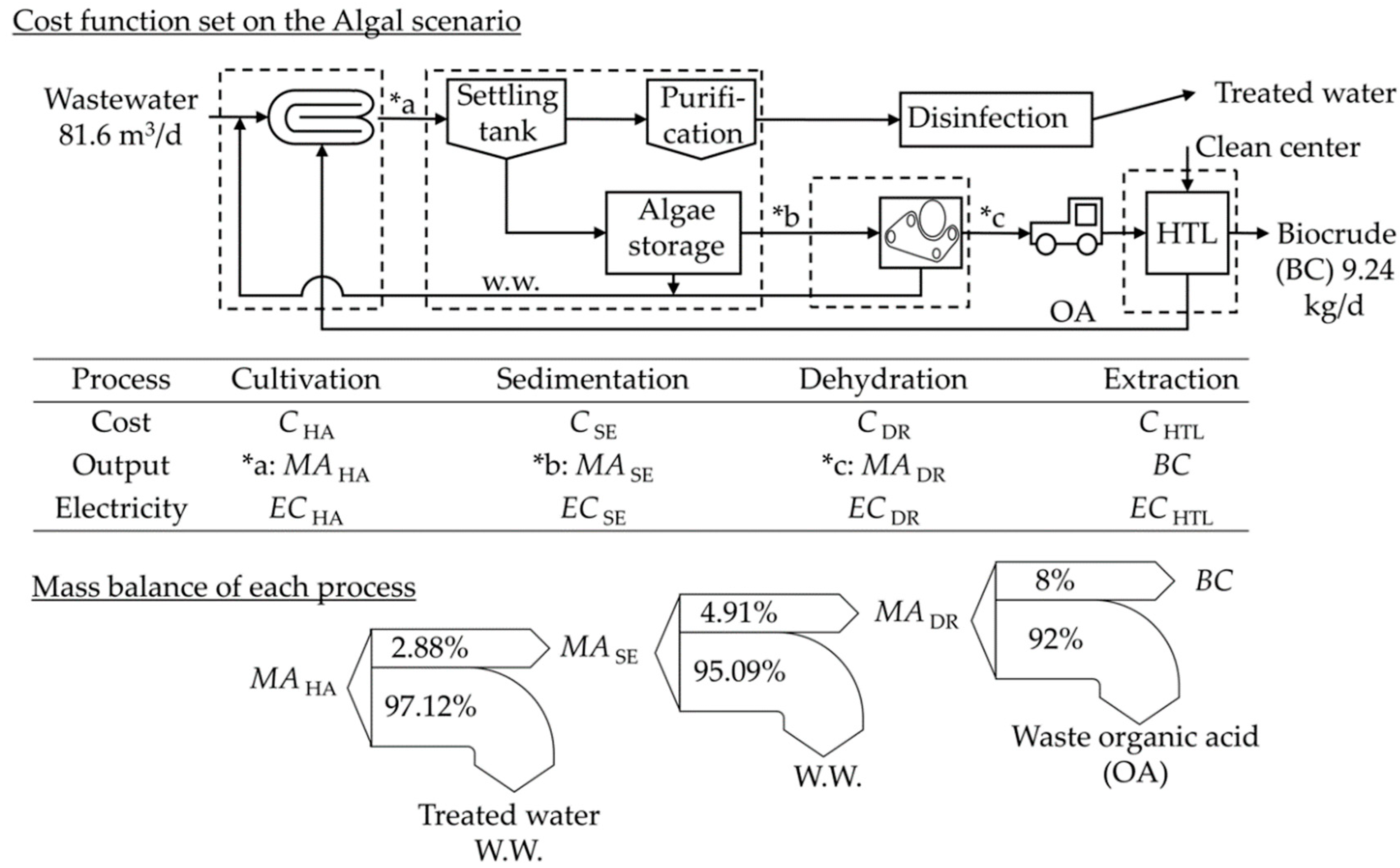

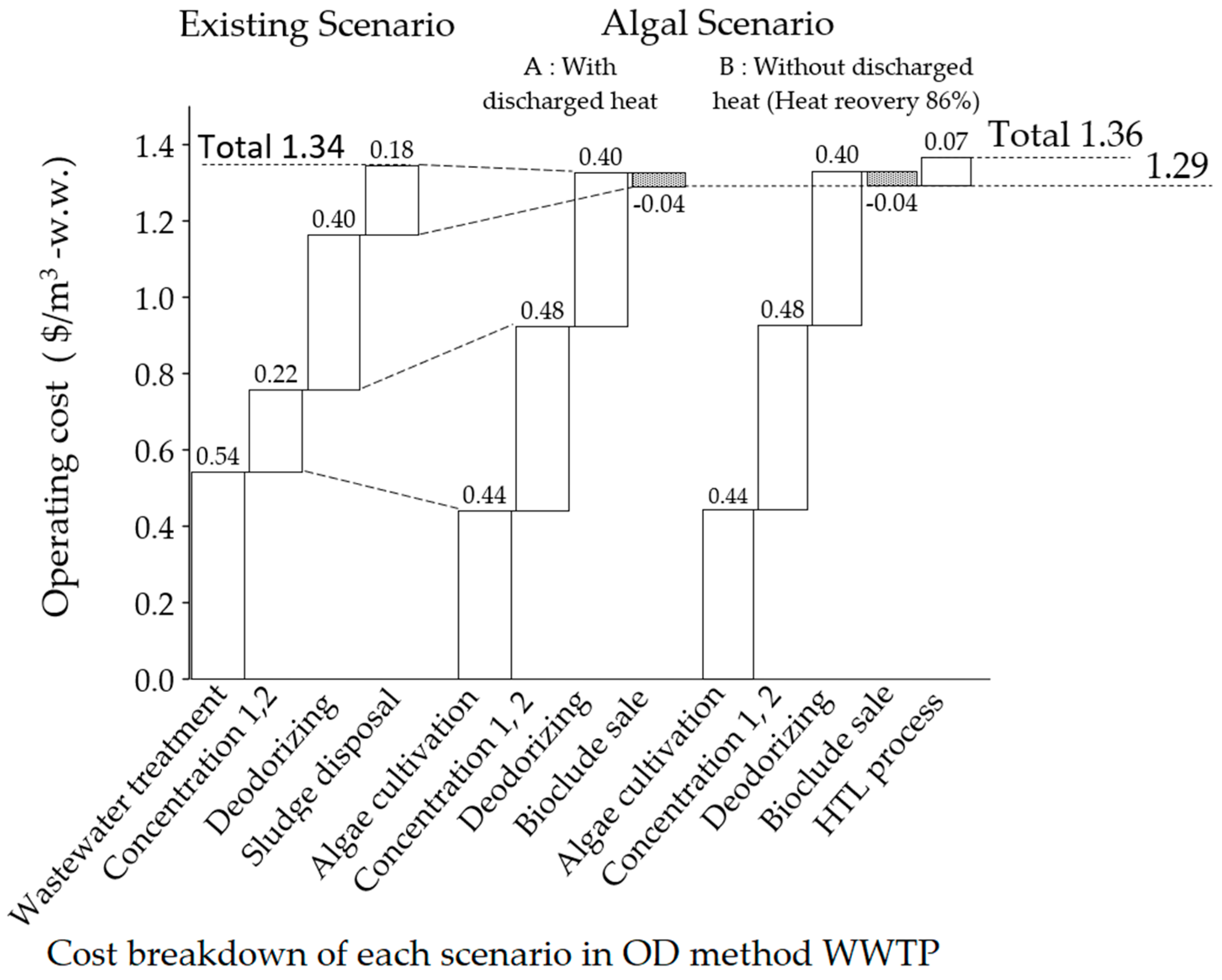
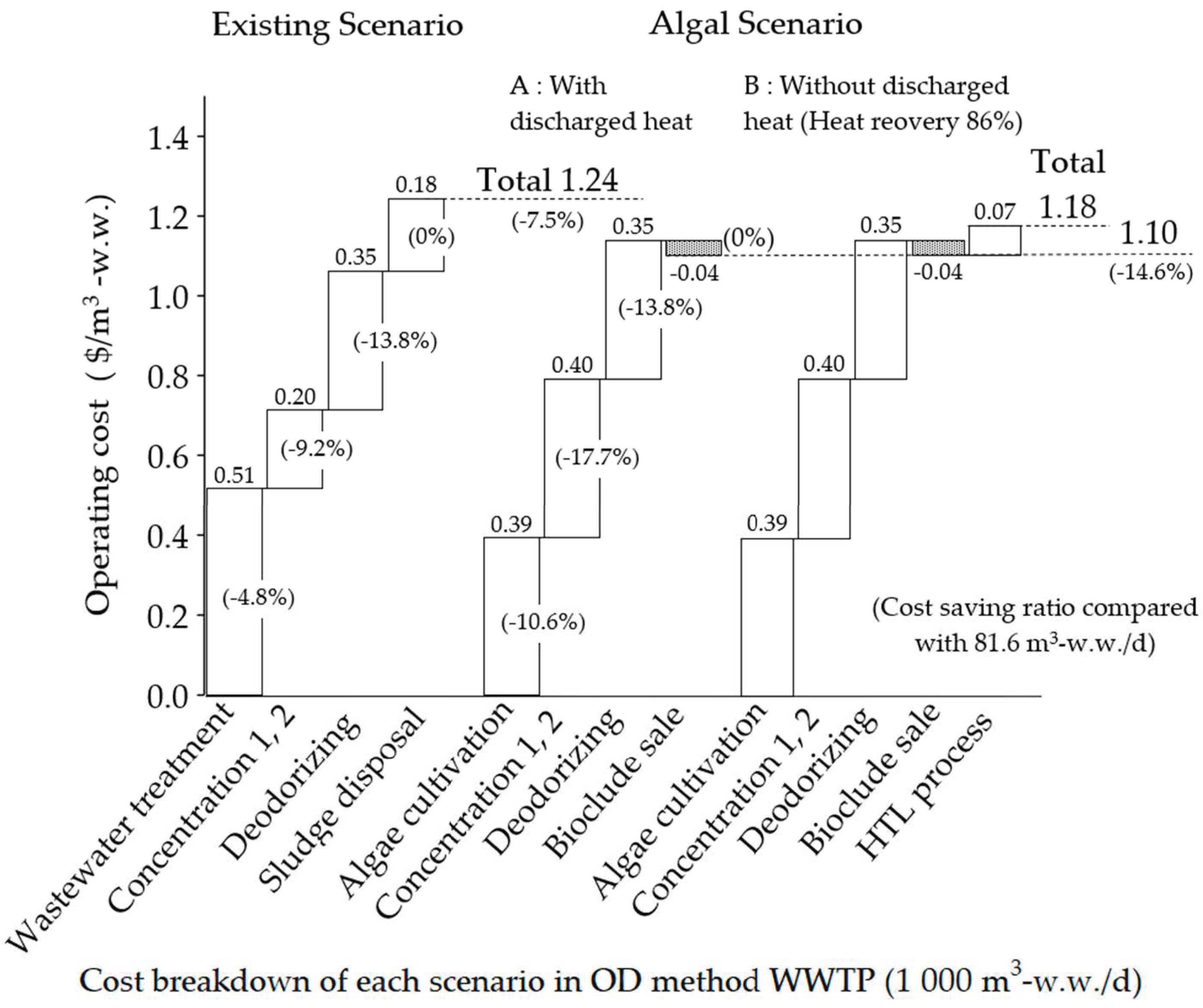
| Facility Utilization Rates | No.* | Name of WWTP | Dewatering Facility | Facility to Supply Exhaust Heat & Discharged CO2 | Direct Distance (km) |
|---|---|---|---|---|---|
| 23% | 6 | Motegi-machi | Yes | Haga Area Eco Station | 19.9 |
| 33% | 5 | Awano | Yes | Kanuma City Clean Center | 6.8 |
| 41% | 1 | Nishizawa | No | Kanuma City Clean Center | 6.1 |
| 44% | 2 | Minaminasu | Yes | South Nasu Wide Area Clean Center | 7.3 |
| 51% | 3 | Niida | Yes | Shimodahara Clean Center | 10.2 |
| No. | Nutrient | Acetic Acid | 15% CO2 | Culture Pond ** | HRT | Harvest | Productivity (Per Culture Volume) | Ref | ||||||
|---|---|---|---|---|---|---|---|---|---|---|---|---|---|---|
| C* | W.W. | C* | from HTL | Volume | Depth | Surface Area | C** | Yield | ||||||
| g/L | g/L | mL/min/L | L | m | m2 | d | g/L | L/d | g/L/d | g/m2/d | ||||
| 1 | ✓ | - | 0.30 | - | ✓ | 200,000 | 0.2 | 1000 | 4 | 0.340 | 50,000 | 0.085 | 17.00 | [17] |
| 2 | - | ✓ | - | - | 0.6 | 100 | 0.2 | 0.71 | 4 | 0.203 | 25 | 0.051 | 7.16 | [3] |
| 3 | - | ✓ | - | - | 0.6 | 210 | 0.4 | 0.71 | 4 | 0.138 | 53 | 0.035 | 10.25 | [3] |
| 4 | - | ✓ | - | - | 0.6 | 450 | 0.8 | 0.69 | 4 | 0.118 | 113 | 0.030 | 19.21 | [3] |
| 5 | - | ✓ | 0.30 | - | 0.6 | 100 | 0.2 | 0.71 | 4 | 0.182 | 25 | 0.045 | 6.41 | [3] |
| 6 | - | ✓ | 0.30 | - | 0.6 | 210 | 0.4 | 0.71 | 4 | 0.196 | 53 | 0.049 | 14.50 | [3] |
| 7 | - | ✓ | 0.30 | - | 0.6 | 450 | 0.8 | 0.69 | 4 | 0.148 | 113 | 0.037 | 24.06 | [3] |
| 8 | - | ✓ | 0.15 | 0.15 | ✓ | 326,267 | 0.8 | 408 | 4 | 0.148 | 81,567 | 0.037 | 29.61 | |
| Parameter | Algal | OD Process |
|---|---|---|
| Treatment volume (m3/d) | 81.6 | 81.6 |
| Base volume (m3/d) | 81.6 | 847.9 |
| Labor cost in the Awano WWTP | Included | Included |
| Labor cost in the Clean Center | Not included | - |
| Algal transfer fee | Not included | - |
| Recycle Acetic acid transfer fee | Not included | - |
| Disinfection cost | Not included | Not included |
| Construction fee | Not included | Not included |
| Maintenance fee | Included | Included |
| Variable | Description | Reference Value | Unit | Remarks |
|---|---|---|---|---|
| d | The depth of open raceway pond (ORP) | 0.8 | m | Productivity is changed by the depth |
| A | The surface area of ORP | 408 | m2 | Reuse of existing pond |
| WW | Wastewater used as a solvent | 81.6 | m3/d | - |
| ρ | Volumetric mass density | 1 | t/m3 | - |
| MAHA | Mass of the algal suspension at harvest | 81.6 | t/d | SS * weight ratio 0.015% |
| MASE | Mass of the algal suspension after coagulation and sedimentation | 2350 | kg/d | SS weight ratio of 1.156% |
| MADR | Mass of the algal suspension after drum-filtration | 115.5 | kg/d | SS weight ratio of 20% |
| BC | Biocrude | 9.24 | kg/d | Biocrude-wet [2] |
| DS | Dehydrated sludge | 56.7 | kg/d | (Existing scenario) |
| OA | HTL water phase (Contains organic acid) | 106 | kg/d | Use as heterotrophic |
| C | Total operation cost | 4002 | JPY/d | Not included disinfection and CHTL |
| CHA | Operation cost of cultivation | 1458 | JPY/d | Free exhausted CO2 |
| CSE | Operation cost of sedimentation | 2255 | JPY/d | - |
| CDR | Operation cost of dehydration | 290 | JPY/d | - |
| (CHTL) | Operation cost of extraction (HTL) | 4594 | JPY/d | Free when using waste heat |
| ECHA | Electricity consumption of cultivation | 33.1 | kWh/d | - |
| (ECPW) | Paddlewheel part in the cultivation | 19.8 | kWh/d | - |
| (ECPUMP) | Pump part in the cultivation | 13.3 | kWh/d | - |
| ECSE | Electricity consumption of sedimentation | 62.2 | kWh/d | - |
| ECDR | Electricity consumption of dehydration | 11.1 | kWh/d | Drum-filter |
| ECHTL | Electricity consumption of extraction (HTL) | 176.7 | kWh/d | - |
| RDR | Utilization rate within the drum-filter working hour | 98 | % | - |
| RHTL-U | Utilization rate within the extraction (HTL) working hour | 80 | % | Algal scenario B |
| RHTL-H | Heat recovery rate within the extraction (HTL) | 86 | % | Algal scenario B |
| NPW | Number of paddle wheels | 1 | unit | 1 unit/1000 m2 |
| NPUMP | Number of the pump unit 1 unit includes 2 pumps (In-Out) | 1 | unit | 1 unit/1000 m2 |
| NHTL | Number of HTL | 5 | unit | - |
| WPW | Power consumption of paddle wheel | 2.20 | kW/h/unit | Table 5: e4 |
| WPUMP | Power consumption of the pump | 0.67 | kW/h/unit | Table 5: e1 |
| WSE | Power consumption of settling tank | 2.59 | kW/h/unit | Table 5: e2 |
| WDR | Power consumption of drum-filter | 1.42 | kW/h/unit | Table 5: e3 |
| WHTL | HTL heater output 10.2 kWh × 18% | 1.84 | kW/h/unit | Catalog value |
| α | Processing capacity of the pump | 136 | L/min | - |
| β | Processing capacity of the settling tank | 3.4 | m3/h | - |
| γ | Processing capacity of drum-filter | 300 | kg/h | Minimum 300 kg/h |
| δ | Processing capacity of HTL | 1.2 | kg/h | [3] |
| Price | Description | Setting Value | Unit | Remarks |
| PBC | The sales price of Biocrude | 35.0 | JPY/kg | 45 USD/barrel |
| PDS | Disposal cost of dehydrated sludge | 28.8 | JPY/kg | (Existing scenario) |
| PAA | Price of sodium acetate | 55 | JPY/kg | - |
| PEC | electricity charges | 26 | JPY/kWh | - |
| PCO2 | Carbon dioxide purchase | 320 | JPY/kg | Used at 15% |
| PCO2’ | The sales price of carbon credit | −1.8 | JPY/kg | - |
| PPC | Price of polymer flocculant | 500 | JPY/kg | - |
| PPS | Price of Inorganic coagulant | 25 | JPY/kg | Iron (II) polysulphate |
| $(USD) | Exchange rate | 109 | JPY/USD | Ave. 2019 |
| Constant | Description | Setting Value | Unit | Remarks |
| HRT | Algal hydraulic retention time | 4 | d | - |
| c | Harvested algal suspension concentration | 0.148 | g/L | Table 2: changes with d |
| AA | The usage rate of sodium acetate | 0.15 | kg/m3-w.w. ** | Table 2 |
| whPW | Working hour of paddle wheel | 18 | h/d | - |
| whDR | Working hour of drum-filter | 8 | h/d | - |
| whPUMP | Working hour of pump | 10 | h/d | - |
| whEQ | Working hour of Equipment | 24 | h/d | Constant operation |
| whHTL | Working hour of HTL | 24 | h/d | - |
| CO2HA | CO2 absorption in the cultivation process included at harvesting | 0.639 | kg/m3-w.w. | - |
| PCHA | Polymer flocculant (Algal harvest) | 0.0030 | kg/m3-w.w. | |
| PCPU | Polymer flocculant (Water treat) | 0.0005 | kg/m3-w.w. | |
| PS | Inorganic coagulant (Water treat) | 0.25 | kg/m3-w.w. | Iron (II) polysulphate |
| No. | Parameters f(x) (kW) | Equation f(x) = ax + b | x | unit | a | b | R2 |
|---|---|---|---|---|---|---|---|
| e1 | Pump | f(x) = 0.0029x + 0.2725 | Capacity(α) | L/min | 0.0029 | 0.2725 | 1.00 |
| e2 | Flocculant machine | f(x) = 0.5972x + 0.5611 | Capacity(β) | m3/h | 0.5972 | 0.5611 | 0.89 |
| e3 | Drum filter machine | f(x) = 0.0202x + 1.4161 | Capacity(γ) | m3/h | 0.0202 | 1.4161 | 0.94 |
| e4 | Paddlewheel | f(x) = 2.75x | Depth(d) | m | 2.75 | 0 | 1.00 |
| Key Assumptions | Existing Scenario | Algal Scenario A | Algal Scenario B | Other Patterns | ||
|---|---|---|---|---|---|---|
| 1 | 2 | 3 | ||||
| Use of exhaust CO2 gas as free | - | ✓ | ✓ | ✓ | - | - |
| Use of discharged heat in HTL | - | ✓ | - | - | ✓ | - |
| HTL heat recovery (RHTL-H) | - | - | 86% | 0% | - | - |
| Operation cost ($/m3-w.w.) (Ratio based existing) | 1.34 (1.0) | 1.29 (1.0) | 1.36 (1.0) | 1.81 (1.3) | 2.80 (2.1) | 3.32 (2.5) |
© 2020 by the authors. Licensee MDPI, Basel, Switzerland. This article is an open access article distributed under the terms and conditions of the Creative Commons Attribution (CC BY) license (http://creativecommons.org/licenses/by/4.0/).
Share and Cite
Ishizaki, R.; Putra, A.S.; Ichikawa, S.; Ahamed, T.; Watanabe, M.M.; Noguchi, R. Microalgae Oil Production Using Wastewater in Japan—Introducing Operational Cost Function for Sustainable Management of WWTP. Energies 2020, 13, 5310. https://doi.org/10.3390/en13205310
Ishizaki R, Putra AS, Ichikawa S, Ahamed T, Watanabe MM, Noguchi R. Microalgae Oil Production Using Wastewater in Japan—Introducing Operational Cost Function for Sustainable Management of WWTP. Energies. 2020; 13(20):5310. https://doi.org/10.3390/en13205310
Chicago/Turabian StyleIshizaki, Riaru, Agusta Samodra Putra, Sosaku Ichikawa, Tofael Ahamed, Makoto M. Watanabe, and Ryozo Noguchi. 2020. "Microalgae Oil Production Using Wastewater in Japan—Introducing Operational Cost Function for Sustainable Management of WWTP" Energies 13, no. 20: 5310. https://doi.org/10.3390/en13205310






